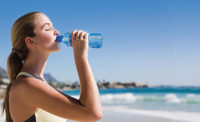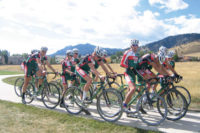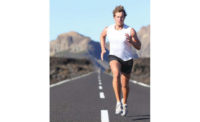Pairing Nutrition with Exercise
Nutrition needs differ for anaerobic versus aerobic exercise


Pure, animal-derived proteins, such as protein powder from poultry, have some of the highest bioavailability and surprising versatility suitable to a variety of formulations.
SOURCE: International Dehydrated Foods Inc. (www.idf.com)

Whey protein from dairy foods has been demonstrated to help improve aerobic exercise performance among runners as well as in resistance exercise.
SOURCE: Dairy Management Inc. (www.dairy.org)



Physical activity is one of the best weapons in the fight against obesity. Whether engaging in weight lifting or jogging, swimming or the 100-yard dash, burning calories and working off fat are as much a part of weight management as maintaining a healthy diet. But activity and diet also are not mutually exclusive. It takes both for complete health. It also takes both types of exercise, anaerobic and aerobic, and each has its own nutrition needs.
Anaerobic exercise is exercise performed in short, intense bursts of a few seconds to a couple of minutes, breaking down glucose and generating lactic acid with the goal of burning up glucose and fats. Aerobic exercise (also called “cardio,” and including such activities as running, rowing, bicycling) can be low- or high-intensity, but occurs over a longer period and works muscles differently. The goal with aerobic exercise, too, is to burn energy from stored calories.
Although there is often a line drawn between aerobic and anaerobic exercise, in reality, there is quite a bit of gray area: People primarily do both types of exercise, and all three “fueling systems”—protein, carbohydrate, and fat—are needed and used. The intensity and duration of the exercise determines whether carbohydrate or fat is the primary source of fuel used, which energy system dominates, and what additional ingredients that can help support training and performance.
Article Index:
- Food to Fuel
- Sustaining Anaerobic Exercise
- Supporting Aerobic Exercise
- The Beet Goes On
- Electrolyte Orchestration
Food to Fuel
Through a series of steps, the human body converts food into a usable form of energy, adenosine triphosphate (ATP), to fuel all cellular function. Very little ATP is stored in the body; therefore, it must be constantly resynthesized to keep up with the demand for energy. “ATP production is always active and proportionate to the level of effort and ATP demand,” says Eddie Jo, PhD, professor of sport and exercise physiology and the director of the Human Performance Research Lab at California State Polytechnic University.
Three different energy systems produce ATP at varying speeds to accommodate varying intensities of exercise: the phosphagen system for fast production; anaerobic glycolysis for intermediate production; and aerobic glycolysis for slow production.
The phosphagen system uses creatine phosphate to resynthesize ATP. Although readily accessible, the amount of creatine phosphate in muscles is small, placing a limit on this system’s ability to produce enough ATP to sustain exercise past one minute in duration. The phosphagen system is important during the start of activity, and for very short-duration activities lasting 30 seconds to one minute.
Aerobic glycolysis uses oxygen to produce ATP from carbohydrates and fats. The rate of ATP production via aerobic glycolysis is slower than both the phosphagen system and aerobic glycolysis, yet it lasts a long time. “The body has an infinite supply of fat, but can quickly run out of glycogen,” explains Kelly Pritchett, PhD, RDN, director of the nutrition graduate program and assistant professor of nutrition and exercise science at Central Washington University (CWU).
Anaerobic glycolysis does not require oxygen to generate ATP from glucose. This makes it an important source of energy during high-intensity activity that lasts from 30 seconds to 2 minutes, when a person is sucking air while exercising. Anaerobic glycolysis is considered an intermediate pathway; it produces ATP faster than aerobic glycolysis yet more slowly than the phosphagen system.
“High maximum-effort exercise, regardless of its common classification as ‘anaerobic training,’ is in fact highly aerobic, since aerobic ATP production is at max capacity,” states Jo. “There is no type of exercise that can isolate anaerobic metabolism.”
All three of these systems are in play during any type of exercise. “Considering the primary fuel source for exercise when developing foods or beverages can make a huge difference in exercise performance and recovery,” says Abbie Smith-Ryan, PhD, associate professor in the department of exercise and sport science at the University of North Carolina. “Understanding whether the product is targeting the needs of an endurance athlete or a sprinter should heavily influence the ingredient profile.”
Smith-Ryan points out that hydration, electrolytes, and newer unique ingredients can be tailored to support primarily anaerobic (sprinter, weight lifting) or aerobic (endurance sports) exercise.
Sustaining anaerobic exercise

Eggs are one of the richest sources of choline, critical in multiple physiological pathways and that can augment endurance performance in persons depleted in the nutrient.
SOURCE: American Egg Board (www.aeb.org)
The organic acid creatine has been touted as an important ingredient for foods and beverages targeting athletes. “For short duration (1-10 seconds), high-intensity exercise such as weight lifting, the ATP-PCr [phosphocreatine] system is the predominant energy system,” says CWU’s Pritchett. “To optimize creatine stores, eat foods rich in protein from meat, fish, and poultry.”
Protein from meat and seafood—and especially eggs—also is rich in choline. Choline is the precursor of the neurotransmitter and, while acetylcholine in the diet is usually sufficient to provide the body’s requirements under normal condition, preliminary evidence has shown that choline depletion could limit performance.
Protein fractions, too, can be of benefit. For example, collagen peptide supplementation in anaerobic resistance training was shown to improve body composition and increases muscle strength in persons with age-related muscle wasting.
In a scholarly review for the International Journal of Sport Nutrition and Energy Metabolism, authors Jay Penry, PhD, and Melinda Manore, PhD, RDN, with the Dept. of Nutrition and Exercise Sciences, Oregon State University, described how choline plays a key role in multiple physiological pathways in addition to synthesis of the neurotransmitter acetylcholine. It is a component of phospholipids for cell-membrane signaling; lipoproteins (needed for lipid transport); and plays a role in homocysteine reduction. “Endurance exercise might stress several of these pathways, increasing the demand for choline as a metabolic substrate,” they wrote.
The Penry and Manore review focused on the links between endurance exercise and choline demand in the human body, as well as the “mechanisms by which exercise might affect blood choline levels, and the links between methyl metabolism and the availability of free choline.” They also assessed the “ability of oral choline supplements to augment endurance performance” and presented evidence that “current [choline] recommendations might be insufficient for some adult men.”
Penry and Manore stress that “only strenuous and prolonged physical activity appears sufficient to significantly decrease circulating choline stores,” adding, “oral choline supplementation might only increase endurance performance in activities that reduce circulating choline levels below normal.”
Vegetarians have less stored creatine than omnivores, yet they also have a greater capacity to store creatine upon consumption compared to meat eaters. This makes vegetarian athletes great candidates for products containing creatine. Supplemental creatine can improve creatine stores, allowing for faster re-synthesis of ATP. Over time, creatine supplementation can augment the results from a well-designed training program, helping improve speed, power, and strength.
“With anaerobic glycolysis, the primary energy system for high-intensity anaerobic exercise lasting between 30 seconds to 2 minutes, this pathway can only oxidize carbohydrate,” says Pritchett. “This means carbohydrate becomes an important fuel source.” Both glucose (from food consumed right before or during exercise) and glycogen are used to support high-intensity exercise, although glycogen is the main form of energy used.
During prolonged intermittent bouts of high-intensity exercise, muscle fatigue will set in as significant amounts of glycogen are used. Small quantities of glycogen are stored in the liver, with more stored in muscle. In total, these glycogen stores constitute approximately 15g of glycogen per kilogram of body weight. However, this is only if a person eats enough carbohydrate and calories each day to maximize glycogen storage.
Skimping on either calories in general or carbohydrates in particular means that glycogen stores will not be full at the start of exercise. Additionally, although muscle glycogen is used during both low- and high-intensity exercise, liver glycogen is used primarily during low-intensity exercise.
Many anaerobic athletes, such as sprinters, compete in very short events. Athletes competing in marathon races typically incorporate some high-intensity training into their regimen. Their bodies will utilize anaerobic glycolysis during sprints in the middle of their race and shortly before the finish line.
These athletes still require substantial carbohydrate intake. “It is not the event that requires significant amounts of carbohydrate so much as the intense training,” states Roberta Anding, MS, RDN, a sports dietitian in the department of orthopedic surgery at Baylor College of Medicine, Houston. “Often, these ‘stop-and-go’ athletes underestimate the amount of carbohydrate needed because they are not running long distances.”
Supporting Aerobic Exercise
Both fat and carbohydrate support aerobic exercise. Fat is a slow source of fuel–it takes longer to produce ATP from fat than from carbohydrate. Therefore, when intensity is lower, a greater percentage of the energy needed to fuel exercise can come from fat. Greater amounts of carbohydrate, primarily from glycogen, are used when intensity ramps up.
Endurance athletes, particularly those training at very low intensities—such as the ultra-endurance runner, cyclist, or swimmer—often opt for a high-fat or ketogenic diet (mainly fat, less than 15% protein, and fewer than 5% of calories from carbohydrate) as opposed to a traditional high-carbohydrate diet. However, there is no evidence to suggest this dietary approach is better than a standard high-carbohydrate diet. Moreover, a low-carbohydrate/high-fat diet can impair performance.
Due to misinformation, too many athletes are missing out on one high-energy, low-calorie, nutrient-rich food: the potato. “The primary reason for the low standing of potatoes among many engaging in prolonged activity is that potatoes have been branded a ‘high Glycemic Index food,’” says Mark Anthony, PhD, adjunct professor of science and nutrition at St. Edwards University, Austin, Texas.

Plant foods are rich in minerals, vitamins, and antioxidants that aid energy production, tissue rebuilding, and endurance while keeping cell machinery functioning smoothly.
SOURCE: ISTOCK
In addition to teaching, Anthony trains championship handball players and is himself a title holder in the high-energy sport. He adds that the Glycemic Index was designed as a measure for helping persons with diabetes, plus results can be altered by so many variables it is irrelevant as a measure of carbo-hydrate quality.
“The mere fact that the lowly spud’s glucose, derived from easily digestible starch, is readily available to the blood makes potatoes a highly valuable muscle-glycogen-loading tool for athletes,” explains Anthony. “Glucose is broken down by glycolysis in the cytosol, the liquid matrix inside the cell. Glycolysis produces ATP via anaerobic metabolism. Then, the pyruvate produced is converted to acetyl coA and goes through the TCA cycle.”
Anthony cautions that this does not mean athletes should eat French fries and potato chips, but steamed or boiled product. “After a workout, when muscles are especially greedy,” he says, “the starch from roots and tubers that have been slow-cooked over low heat can more efficiently replenish this critical store of energy.
“Potatoes specifically, among the root vegetables, are whole foods,” continues Anthony. “They contain vitamins, and minerals valuable to athletes. Although potatoes are low in whole protein, they carry a balance of all the essential amino acids. They also are rich in pyridoxine [vitamin B6], critical to protein metabolism.”
Potatoes also contain a significant amount of vitamin C, even when cooked. “Hard-working athletes need to maintain electrolyte balance,” says Anthony, “and here again, potatoes prove to be valuable as rich sources of potassium, the major electrolyte inside the cell. When glucose is transported into the working muscle cell, it is accompanied by sodium, the major electrolyte outside the cell. A protein embedded in the cell membrane, referred to as the sodium/potassium pump, uses energy to push the sodium back outside while bringing potassium inside the cell. Reestablishing this critical balance uses a significant portion of the athlete’s energy during rest and recuperation.”
Further support for potatoes as a valuable ingredient for athletes is that, properly prepared, they rank high on the Satiety Index. “This measure of how satisfying a single food is, evaluated by the tendency of subjects to be hungry after eating a measured amount of test food, shows the undisputed winner to be the boiled potato,” says Anthony. “Being the food highest on the Satiety Index suggests that boiled potatoes can be a powerful appetite suppressant.”
When boiled and cooled, potatoes also are high in resistant starch. Resistant starch, from whole foods such as potatoes, high-amylose corn, underripe bananas, and other sources, also have a high satiety factor, and can help to lower blood cholesterol.
For those on a diet containing a substantial amount of carbohydrates to support training and performance, beverages, beans, gummies, and other sports nutrition products with multiple forms of carbohydrate are more beneficial than consuming a single source of carbohydrate alone. “A 2:1 glucose to fructose formula has been shown to increase the amount of carbohydrate a person is able to effectively use during exercise,” adds CWU’s Pritchett.
The Beet Goes On
The amino acid beta-alanine is another important ingredient to consider for supporting high-intensity exercise lasting for up to four minutes. Beta-alanine is the rate-limiting substrate in the production of carnosine, a dipeptide (protein fraction) composed of beta-alanine and another amino acid, histidine.
Together, these amino acids buffer acidity from the buildup of hydrogen ions. Studies support intake of between 1.6 and 6.4g per day. Over time, when carnosine stores are fully saturated, the active adult or athlete should notice a decrease in fatigue and muscle heaviness.
A swell of research has investigated the value of foods and ingredients that help increase nitric oxide production, specifically through the nitrate-nitrite-nitric oxide pathway. This metabolic process enhances blood flow when oxygen isn’t readily available. Enhanced blood flow can support exercise and recovery through nitric oxide-boosting foods.
Beets, beetroot juice, pomegranate juice, and other nitrate-rich vegetables—including leafy greens, spinach, celery, and carrot juice—are good sources of this compound. However, growing and storage conditions impact the nitrate content of any given source. Interestingly, research indicates that beetroot juice may have a greater impact on untrained and recreationally active individuals than on competitive athletes who have undergone years of training.

Nitric oxide-boosting foods such as beets, pomegranate and other nitrate-rich vegetables, can enhance blood flow during high-intensity activity, supporting exercise and recovery.
SOURCE: Kayco/Kedem Food Products Inc. (www.kayco.com)
It should be noted as well that vegetables and other plant foods are rich in minerals, vitamins, and antioxidants. All these not only contribute to energy production and endurance but also are necessary for rebuilding tissue and keeping cell machinery functioning smoothly.
Electrolyte Orchestration
All sports drinks should contain sodium to enhance thirst and subsequent fluid intake, as well as for supporting muscle and nerve function. Sodium and chloride are the two primary electrolytes lost in sweat, making good old table salt, comprised of both minerals, all that is needed to ramp up sodium levels in sports nutrition products.
Caffeine is the most widely consumed legal psychoactive agent worldwide. In small amounts, it can enhance mental functioning, particularly when consumed after inadequate sleep. In doses between 3 mg and 6 mg per kg of body weight, caffeine can also enhance performance during both intermittent high-intensity exercise (such as with team sports) and exhaustive exercise.
The amino acid compound l-alanyl-l-glutamine is an ingredient of interest for makers of sports drinks. When added to such formulations, it has been shown to help keep the body hydrated and extend time to exhaustion. Many sports drinks contain both low-dose (300 mg) and high-dose (500 mg) l-alanyl-l-glutamine. Compared to sports drinks without l-alanyl-l-glutamine, they have demonstrated improved time to exhaustion in endurance-trained men.
“Designing nutrition programs for athletes requires an understanding of the physiology of sport,” states Anding. Instead of strictly dividing exercise by aerobic or anaerobic, one should consider the intensity of the exercise as a linear progression to help determine the primary type and amount of fuel used.
Formulators do not need to strictly divide and market to the two types of exercise, but instead can position products based on their specific functional ingredients as well as the resulting specific benefits. These benefits include better hydration, improved blood flow, alertness, and decreased fatigue.
Originally appeared in the October, 2017 issue of Prepared Foods as Something in the Air.
Looking for a reprint of this article?
From high-res PDFs to custom plaques, order your copy today!









